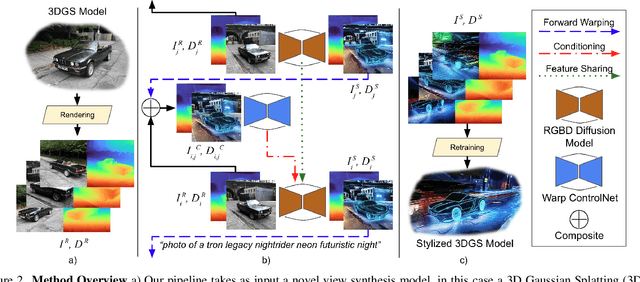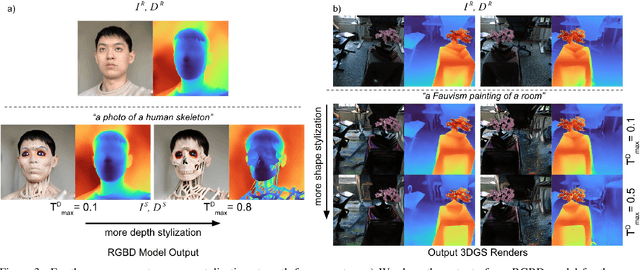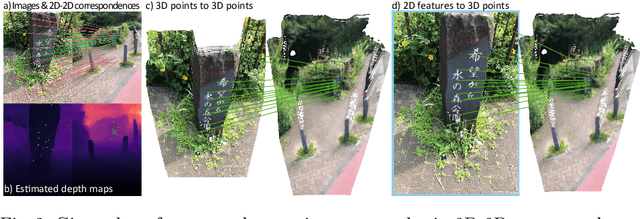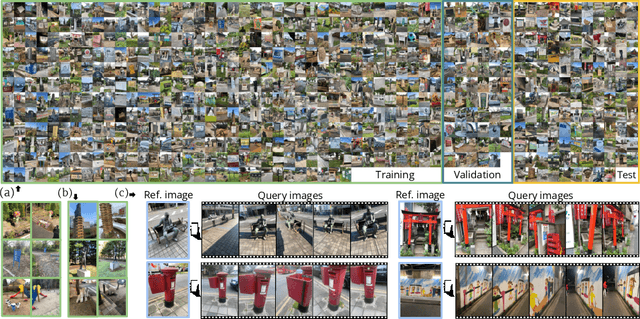Jamie Wynn
Morpheus: Text-Driven 3D Gaussian Splat Shape and Color Stylization
Mar 03, 2025



Abstract:Exploring real-world spaces using novel-view synthesis is fun, and reimagining those worlds in a different style adds another layer of excitement. Stylized worlds can also be used for downstream tasks where there is limited training data and a need to expand a model's training distribution. Most current novel-view synthesis stylization techniques lack the ability to convincingly change geometry. This is because any geometry change requires increased style strength which is often capped for stylization stability and consistency. In this work, we propose a new autoregressive 3D Gaussian Splatting stylization method. As part of this method, we contribute a new RGBD diffusion model that allows for strength control over appearance and shape stylization. To ensure consistency across stylized frames, we use a combination of novel depth-guided cross attention, feature injection, and a Warp ControlNet conditioned on composite frames for guiding the stylization of new frames. We validate our method via extensive qualitative results, quantitative experiments, and a user study. Code will be released online.
Scene Coordinate Reconstruction: Posing of Image Collections via Incremental Learning of a Relocalizer
Apr 22, 2024Abstract:We address the task of estimating camera parameters from a set of images depicting a scene. Popular feature-based structure-from-motion (SfM) tools solve this task by incremental reconstruction: they repeat triangulation of sparse 3D points and registration of more camera views to the sparse point cloud. We re-interpret incremental structure-from-motion as an iterated application and refinement of a visual relocalizer, that is, of a method that registers new views to the current state of the reconstruction. This perspective allows us to investigate alternative visual relocalizers that are not rooted in local feature matching. We show that scene coordinate regression, a learning-based relocalization approach, allows us to build implicit, neural scene representations from unposed images. Different from other learning-based reconstruction methods, we do not require pose priors nor sequential inputs, and we optimize efficiently over thousands of images. Our method, ACE0 (ACE Zero), estimates camera poses to an accuracy comparable to feature-based SfM, as demonstrated by novel view synthesis. Project page: https://nianticlabs.github.io/acezero/
DiffusioNeRF: Regularizing Neural Radiance Fields with Denoising Diffusion Models
Feb 23, 2023Abstract:Under good conditions, Neural Radiance Fields (NeRFs) have shown impressive results on novel view synthesis tasks. NeRFs learn a scene's color and density fields by minimizing the photometric discrepancy between training views and differentiable renders of the scene. Once trained from a sufficient set of views, NeRFs can generate novel views from arbitrary camera positions. However, the scene geometry and color fields are severely under-constrained, which can lead to artifacts, especially when trained with few input views. To alleviate this problem we learn a prior over scene geometry and color, using a denoising diffusion model (DDM). Our DDM is trained on RGBD patches of the synthetic Hypersim dataset and can be used to predict the gradient of the logarithm of a joint probability distribution of color and depth patches. We show that, during NeRF training, these gradients of logarithms of RGBD patch priors serve to regularize geometry and color for a scene. During NeRF training, random RGBD patches are rendered and the estimated gradients of the log-likelihood are backpropagated to the color and density fields. Evaluations on LLFF, the most relevant dataset, show that our learned prior achieves improved quality in the reconstructed geometry and improved generalization to novel views. Evaluations on DTU show improved reconstruction quality among NeRF methods.
Map-free Visual Relocalization: Metric Pose Relative to a Single Image
Oct 11, 2022



Abstract:Can we relocalize in a scene represented by a single reference image? Standard visual relocalization requires hundreds of images and scale calibration to build a scene-specific 3D map. In contrast, we propose Map-free Relocalization, i.e., using only one photo of a scene to enable instant, metric scaled relocalization. Existing datasets are not suitable to benchmark map-free relocalization, due to their focus on large scenes or their limited variability. Thus, we have constructed a new dataset of 655 small places of interest, such as sculptures, murals and fountains, collected worldwide. Each place comes with a reference image to serve as a relocalization anchor, and dozens of query images with known, metric camera poses. The dataset features changing conditions, stark viewpoint changes, high variability across places, and queries with low to no visual overlap with the reference image. We identify two viable families of existing methods to provide baseline results: relative pose regression, and feature matching combined with single-image depth prediction. While these methods show reasonable performance on some favorable scenes in our dataset, map-free relocalization proves to be a challenge that requires new, innovative solutions.
 Add to Chrome
Add to Chrome Add to Firefox
Add to Firefox Add to Edge
Add to Edge